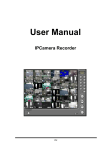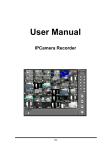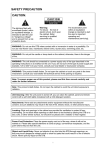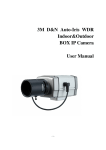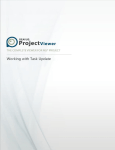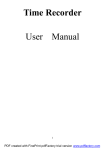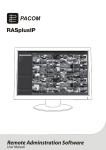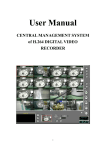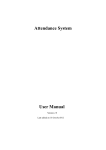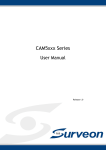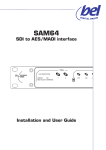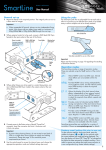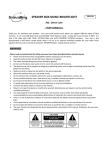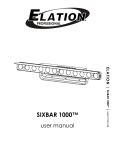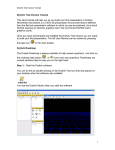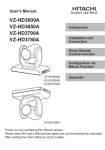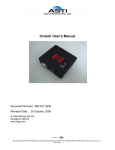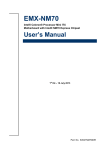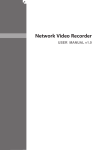Download CMS User`s Manual - Back to Main Page
Transcript
CMS User’s Manual Network Recording Software VERSION 1.0 ENGLISH 1/50 Index I. PREFACE…………………………………………………………………………………….…………3 II. SYSTEM REQUIREMENTS…………………………………………………………………….….....3 A. MINIMUM REQUIREMENTS……………………………………….…………………………..…3 B. SUGGESTEDREQUIREMENTS……………………………………...…………………….........3 III. PROGRAM INSTALL AND UNINSTALL……………………………………………………........…4 A. PROGRAM INSTALL……………………………………………….…………………………....…4 B. UNINSTALL……………………………………………………………………………………...…..6 IV. LIVE VIDEO MONITORING……………………………………………………………………….…..7 V. CMS SETUP……………………………………………………….....……………………………….10 A. NRS SERVER SETUP……………...................................................................................…10 B. NRS GROUP SETUP…………………………………………….…………………………….....11 VI. SYSTEM………………………………………………………………….........................................14 VII. CHANNEL………………………………………………………………….……………………….....18 A. GENERAL…………………………………………………………………………………….…....18 B. SCHEDULE RECORD SETTING………………………...………………………………..........23 C. MOTION DETECTION………………………………………….………………………...….......24 D. MASK………………………………………………………………………………..…………......25 E. PTZ SET UP AND CONTROL……………………………………………………………………26 F. I/O SETUP……………………………………………………………………..…………………..28 G. MOTION/ALARM EVENT SETUP………………………………………………………….……29 VIII. USER MANAGEMENT…………………………………………………………………………........30 IX. DISK…………………………………………………………………………………………...........…31 X. E-MAP…………………………………………………………………………………………..……...31 A. E-MAP SETTING……………………………………………………………………...................31 B. E-MAP ACTION……………………………………………………………….…………………...36 XI. SYSTEM REPORT…………………………………………………………………………………....40 A. REMOTE [LOCAL/SERVER] REAL TIME RESOURCE REPORT………….……………....40 B. REMOTE SERVER BIT-RATE HISTORY REPORT………………………….…………….....41 C. REMOTE SERVER COUNTING HISTORY REPORT………………………….………….....41 XII. VIDEO PLAYBACK…………………………………………………………………………………...42 A. VIDEO PLAYBACK………………………………………………………………………..……....42 B. TIME SPANNED VIDEO LIST………………………………………………………..................44 C. EXPORT VIDEO…………………………………………………………………………………...47 XIII. PRODUCT SPECIFICATIONS…………………………………………………………….……......48 XIV. GRAPHIC CARD TEST TABLE……………………………………………..................................50 2/50 I. PREFACE Central Management System (CMS) is a 16 views recording software which specific supports Network Recording Software (iSS-4/9/16/36/72 series). This software can integrate with remote and provide real-time monitor, record the video on PC and then playback the recorded video to the user. Moreover, all of the CMS setting is synchronies between CMS and NRS server. The user can also setup the software recording method for the specific circumstances and performs video playback via Time and Event Search. II. System Requirements A. Minimum requirements i. ii. iii. CPU:Intel Pentium 4 2.0G Memory:1GB VGA card:128MB External Graphic Card or above iv. v. vi. Monitor Resolution:1024 x 768 ( Min.) OS:Windows Server 2003 / Windows 2000 / XP / Vista / Win7 File System:NTFS* (*Network Recording Software still can operate in FAT32 file system. However, it will waste much time while set up the volume of hard disk and it is worse when write the recording data into the hard disk. Therefore, FAT32 file system is not suggested to use.) B. Suggested requirements i. ii. CPU:Intel Core 2 Duo E7200 or above Memory:2GB or above iii. VGA card:512MB External Graphic Card or above iv. (Recommended ATI chipset) Monitor Resolution:1024 x 768 ( Min.) or above v. vi. OS:Windows 7 / Vista / XP / 2000 File System:NTFS 3/50 III. Program Install and Uninstall A. Program Install i. To install CMS SOFTWARE, please double click. Please select the language you would like to use. Network Recording Software supports”Danish”,”English”,”French”, ”German”,”Italian”,”Japanese”,”Polish”,”Portuguese”, ”Russian”,”Simplified Chinese”,”Spanish”, Traditional Chinese”. ii. License Agreement. Select “I Agree”, Go to the next step. iii. Select the directory for CMS SOFTWARE. The default directory is "C:\Program Files\CMS Program ". Select “Next”. 4/50 iv. Set up the name of the program folder. The default is “CMS Software”. Click “Install” to start the installation. v. When finish, click “Close” to close the procedure of the installation. 5/50 vi. To start the program, select “Start” ”Program””” CMS Program””CMS”. NOTE: :In Windows Vista / Windows 7 OS, please right-click on the desk short cut or the main program, select “Run as administrator” to start the program. B. Uninstall i. To uninstall the program, select “Start” ”Program” ”CMS Program” ”Uninstall” to remove the program. 6/50 IV. LIVE VIDEO MONITORING i. NETWORK RECORDING SOFTWARE series support different kinds of real-time monitoring mode. Please refer to following example for different versions depending on different channels. a. 4 Channel version:Switchable 4CH b. 9 Channel version:Switchable 9CH c. 16 Channel version:Switchable 16CH 、1CH 、4CH 、9CH 、1CH 、4CH 、 1CH ii. :Full Screen mode:To exit the full screen mode, use “Esc” or Right-click the mouse. iii. :Minimize the program. iv. :Auto switching channel. Users can set switching time interval ,and determine the initial screen split value . v. :Manual recording: To start recording immediately. To stop recording, click the button again. vi. :Recorded video playback. 7/50 vii. :Get into administration page. viii. :Get into E-Map ix. :Close the program x. : It shows the status of each channel. :Indicate the video recording status. :Indicate Motion Detection. :Indicate Alarm status. xi. PTZ controller interface:Provides Focus、Zoom、IRIS、Auto/ Stop Patrol and Preset Point control. xii. Digital Zoom Control Panel:After selected the channel, the extra image zoom window will be displayed to control the digital zoom in/out. 8/50 a. Preview window: The image or video in the preview window is not live, the image frame will be updated within a time interval. The red frame indicates the live-viewing window, and the number of the left-down corner indicates the zooming rate. 1. Digital zooming bar:By moving the control bar up or down, the live-viewing and preview window will be zoomed in or out. The zoom rate is from 100% to 1000%. 2. Zoom status: By un-check this function, the image or video will be displayed in the original size. 3. The default of the digital zoom is enabled. User can change the default by clicking in the main page and click enter the channel setup page. Check disable digital zoom control. xiii. :I/O switch. There are up to 4 I/O controls. ( if remote device supported) 9/50 to to V. CMS SETUP Please setup Central Management System step by step according to the following instructions. A. NRS SERVER SETUP i. Enable “Remote AP Server” from NRS server ii. Go back CMS program and Click page, select iii. button to enter administrator tag. Options:Add/ Delete/ Edit and Connect server. Note:CMS port is 2222 Step 1:Insert Server Name、IP address、Port2222、ID and Password. Step 2:Click on the icon to add NRS server; also utilize icon to delete NRS server. Step 3:Double click Enable to check the box Step 4:Click on the Server Enable or Disable. icon to connect NRS server. 10/50 B. NRS GROUP SETUP i. Click button to enter administrator page, and select tag. : Add Group / Camera : Delete Group / Camera : Move up Group / Camera : Move down Group / Camera ii. After finish adding NRS server, Server List block will display live of the NRS server channels status which is connecting And NRS server disconnecting 11/50 . 、disconnecting iii. Click “Group List” to create a new group; name the group for future reference. NOTE: :The maximum of one group is 64 CHs. iv. Select a camera(s) from the list and then drag and drop it to where you want the image to be displayed. 12/50 v. Also, you can double click channel of the group to edit the channel’s name. vi. Click Save and exit. vii. Go back to live screen and click “Group list” viii. Select which group you want to connect it. Double click “Group List” icon , Group List window will close. 13/50 VI. SYSTEM i. Multi-Monitor setting: :Under the PC connects Multi-Monitors (it refers to exceed two monitors), the user can select what is displayed on the connected monitors. This function can be worked while the PC installs graphic card which is supported Multi-Monitors* and connects more than one monitor. Moreover, Network Recording Software series will detect the quantity of connecting monitors. (* Normally, the graphic cards which is supported to Multi-Monitors are D-SUB + DVI interface and has to connect one D-SUB monitor and one DVI monitor. Moreover, some graphic cards will have DVI to D-SUB connector. Through the connector, the graphic card can support D-SUB + D-SUB interface and can connect two D-SUB monitors such as ASUS A9200SE. Nowadays, the higher level graphic card can support DVI + DVI interfaces, and has to connect two DVI monitors.) It could be performed the following setting after connected multi-monitors and reboot the PC. a. Click the disable monitor number (i.e. No.2 in the following image.) and select “Extent my Windows desktop onto this monitor” option. 14/50 b. Drag and drop the monitor icon to correspond the actual monitor position. Log Write: :Please select which log ii. file to save. To export system’s log file to some files such as Excel or CSV files, please press iii. Keyboard Lock: :Check button to process. to enable keyboard lock. By enabling this function, the application hotkey will be disabled (i.e. Ctrl + ESC、Alt + Tab、WIN and Alt+F4) to avoid illegal usage. iv. Windows reboot: :Click to set up the time to reboot Windows automatically. It will re-start the NETWORK RECORDING SOFTWARE automatically. 15/50 v. Program auto-run: : To run the program whenever the PC is reboot. vi. E-mail alert: :When the motion is triggered, NETWORK RECORDING SOFTWARE sends the e-mail to some specific account. a. Get into administration page. Click . b. Check c. Click 1. E-MAIL setup page: To enable e-mail service, please fill in the . to get into setup page. name of SMTP server. To verify the user, please check ,and fill in the user account and password. Click to test the e-mail service. 2. The default value of "From” is auto created. 3. Please fill in the e-mail destination address such as [email protected]. 4. “Subject” and “Content” column: The title and the reminder of a triggered event. 16/50 5. Check to attach the triggered event and image to the pre-set e-mail address. 6. In the e-mail setup page, click to add more e-mail addresses to the sending list; or click to delete from the sending list. Attention: The E-mail server will not send the e-mail and the attachment if the check box of the sending list is unchecked. vii. Auto Logout: :Check ,the system will automatically logout within the pre-set time ,if there is no keyboard or mouse event detected. viii. HDD setup: : a. NETWORK RECORDING SOFTWARE series will overwrite the old data when the HDD is full. Click to enable/ disable this function. b. ix. Date Format: : a. b. x. The default configuration of this function is enable. There are 5 different date formats available Please save the changes before exiting. Product Information: : a. Click to show product information. 17/50 . VII. CHANNEL Note:Monitor and setting the remote IP camera channel status synchronized with NRS server (Network Recording Software IVS). Any settings which will run wait for server response message base on network bandwidth transaction data. The setting priority rule base on First in / First out. A. General i. Setup IP camera/ video server in the administration page a. Select to enter IP camera/ video server set up page. b. There are 18 channels listed on the left side of the administrator page. Users can use channels. to select 1-18,19-36, 37-54,55-57 In addition, users can use either keyboard to enter the setup values or by using the mouse to click virtual keyboard to configure each channel. 18/50 and active the c. Camera can be configured in the general setup page. First, click to enable each channel and to set each camera. d. Please select channel type (Normal or Attached): Normal: The same as the main setup page. Attached:If user selects one channel (ex.CH2) as attached channel type, then user is capable to attach one different channel (ex CH1) to CH2. It will result CH2 is the same as CH1. Also, CH2 is not physically linked to any camera; therefore, CH2 will not cost any loading of camera. 19/50 Application of attached channel: : Attached channel type can operate with the digital zoom function. User can select different spots in the main channel and attach to different attached channels. Because attached channel type is not physically linked to any camera; therefore, such channel will not cost any loading of camera or HDD space. For instance, the following figure shows that CH2, 3 and 4 is only apart of the CH1. e. In the basic setting as showed below, channel name can be saved in the “Channel Tag” to distinguish each channel. IP address is indicating the channel. With IP Share (Router), the Port needed to be adjusted in case of conflict. Fill in the ID and the Password for each channel, then click Click to connect each device or channel. will enable IE to browse each channel. 20/50 f. Within the Image setup page as showed below, users can change image Resolution, Quality, Video Format, and Frame Rate. g. In the Pre & Post Alarm Recording setting page as showed below, users can change the recording time interval. h. In the Information setting page as showed below,Tag / Date / Time can be displayed on the live viewing。 21/50 i. In the Display setting page as showed below,users can select display mode. When “Display I frame only” is checked, only one I-Frame will be transferred and displayed in live-viewing; Enabling “Disable Digital Zoom” causes live-viewing to display the original image size (as showed below). j. In the Audio setting as showed below,click “Enable Audio” to enable audio recording. k. In the Security setting page as showed below, click “Hide Camera” to hide camera images from live-viewing. 22/50 l. Before exiting administration page, remember to click all the configurations. m. Moreover, in Advanced Setup, click to save to setup the tag, Date /Time and status location of each shown channel. Click within advanced setting can setup such as the size, format and color of tag, Date/Time and status. NOTE: : The advanced setting will apply to all shown channels. B. Schedule record setting NETWORK RECORDING SOFTWARE series support different recording mode for different channel. i. Get into administration page. Click ii. Select channel to set up the schedule. Select “Schedule” tab. 23/50 . iii. NETWORK RECORDING SOFTWARE series supports 5 recording modes, General (red), Motion detection (yellow), Alarm detection(blue), Motion with alarm detection(green), and No record (white). iv. Use mouse to select time then choose what kind of recording mode to use. v. Click vi. Besides daily schedule recording, NETWORK RECORDING SOFTWARE series supports specific time recording. Determining to make all the channels using the same recording mode. start/end time then click to add to schedule. Notice: : specific time recording has higher priority than daily schedule. C. Motion Detection Each channel can set up 3 areas to detect to motion. i. Get into administration page. Click ii. Select channel to set up the motion, Select “Motion” tab. iii. Detection Area Setting: Click area, the use mouse to draw the area to detect motion. iv. Motion Sensitivity: adjust the sensitivity for each channel. 24/50 D. MASK NETWORK RECORDING SOFTWARE series support different mask areas in each channel; moreover, there are 3 mask areas can be setup. i. Get into administration page. Click ii. Select channel to set up the mask, Select “Mask” tab. iii. Select the Mask Area and then drag and pull the mask area. iv. After complete the mask setup, the live view will be shown as the following image: 25/50 E. PTZ Set up and Control NETWORK RECORDING SOFTWARE series support remote PTZ control. i. Get into administration page. Click ii. Select the channel which supports PTZ, Select “PTZ ” tab. iii. NETWORK RECORDING SOFTWARE series support different PTZ protocols. iv. Make sure to choose the right protocol, ID, baud rate. v. Detecting point preset setup: Please refer to following figure. 26/50 vii. PTZ Custom Command Group: Currently, PTZ custom command only supports video server. This function provides the user to add or define its own command within the provided protocol. Moreover, the user can create a new protocol as well. Click button will reveal the following image, User can define its own command, the instructions of each button are shown in the following; 27/50 1. : Add/ Delete Custom Command. 2. : Move Up/ Move Down Custom Command. 3. : Add/ Delete Custom Command Group. 4. 5. viii. : Test the function of Custom Command. : OK/ Cancel. When finish the PTZ setup, use the control panel to control the PTZ. F. I/O Setup i. Get into administration page. Click ii. Select the channel which supports I/O, Select “IO ” tab. iii. Network Recording Software series support 2 types of I/O. Users can determine delay time interval from 1 to 60 seconds. iv. In the live-viewing, I/O interface may have different controller depending on each channel or remote device. 28/50 G. Motion/ Alarm Event Setup i. Get into administration page. Click ii. Select the channel which supports I/O, Select “IO” tab. iii. The response actions are shown in the following when motion and alarm are triggered. a. E-Mail: Send the E-Mail. Please click and then click b. option first, button to complete the relevant setting. Play Sound: Setup the time of play sound. (NOTE:0 sec is represented the sound is continuing until the user clicks the triggered channel.) The user can select the sound from the buzzer or the specific sound file by clicking button. Moreover, after complete the sound file setting, please click to test the selected sound file. c. Pop Up: If the selected channel is triggered, the program will pop-up and display the triggered channel in the full screen mode. Furthermore, the user can select the pop up time as well. (NOTE: 0 sec is represented the full screen of the triggered channel is continuing displayed and will not back to the split screen mode.) 29/50 VIII. User Management NETWORK RECORDING SOFTWARE series support simple security control. i. Click to get into administration page. ii. On the left side of the administration page, please check the authority type, key in the “Group Name” and click the list. Click iii. to add the new Group to to delete the group. On the right side of the administration page, please fill in the user name, password and select the group. Click to add new user and click to delete. iv. After configuration, please leave the administration page. In the live-viewing page please click 30/50 to login/logout. IX. Disk The HDD Resource Management Tool could detect whether the remote server PC’s setting of available data storage quantity. i. Start the program, enter administration page and click the disk setup page. ii. Before the space is set up on NRS server PC, which the software installed the folder path and available resources of HD space. X. E-Map A. E-Map Setting Get into administration page. Click to set up the E-map. 31/50 button to In the following, the screen of E-map setting will separate into three blocks to instruction. Block 1: :User can right click the mouse to setup the map :The icon of devices which can drag and pull to the map. Block 2: : Add the alarm in the map. Click the icon can see the live view of alarm device. : Add the camera in the map. Click the icon can see the live view of the camera. : Add the map in the map. Click the map icon will link to another map. Block 3: : i. Add the E-Map: :The fundamental operating steps of add a new E-Map a. Select the Node first to add a new E-Map. Such as “Root” node in the beginning. 32/50 b. Drag and Pull of block 2 to block 3 and the following dialogue box will pop-up. User can click button to complete the setting or click the drop down list to select the map. After click the drop down list, then select ”Create New Map (Not Link to Existed Map)” option. The following dialogue box wills pop-up. Click button to select the image of the map and key in the name of new map in Map Node Name input field. Finally, click to complete the new map setting. 33/50 ii. Add the E-Map Link The fundamental operating steps of add the link for exist maps. (* Make sure there are more than two maps) As the following image, there are two maps that have setup. If the user wants to create a link of one map into another map, such as the link of “Map2” in “World Map” in above image, please follow the following steps. a. Please click the map in Block 1 which wants to add the link from another map. (i.e. World Map) b. Drag and pull the icon form Block 2 to Block 3, and then select “Map 2” in the drop down list of Node Name. c. Finally, click button to complete the map setting. As the following image, there is a link of “Map2” in the “World Map”. 34/50 iii. Add the camera and the sensor After complete the map setup, drag and pull the icon of camera and sensor ( ) to put the camera & sensor on the map. Moreover, right-click of the mouse on the camera can select the channel number. According to the NETWORK RECORDING SOFTWARE series version, there are different numbers of camera and sensor can be setup. Based on the 72 version for example, not only there are 72 cameras and sensors can be selected, but the direction of the camera can be chosen. The fundamental operating steps of add the new camera. d. Select the map on Block 1 first. Such as “World Map” e. Drag and pull the icon from Block 2 to Block 3. f. Select the channel number of the camera g. Moreover, select the direction of the camera h. Finally, click the . button to complete the camera setup. The fundamental operating steps of add the new sensor. a. Select the map on Block 1 first. Such as “World Map” b. Drag and pull the c. Select the channel number of the sensor d. Finally, click the icon from Block 2 to Block 3. button to complete the sensor setup. 35/50 . iv. Event save time setting : On the right side of the setting page , please determine recording time of the motion or alarm events. NOTE:There are up to 5000 events can be stored. The previous records will be over-write if exceeding 5000 records. v. Auto Enter Playback Mode:By enabling this function when the motion and the alarm events are triggered, the system wills automatically playback the event (E-MAP mode only). vi. B. Click to save the configuration. E-Map Action Click to enter E-map. 36/50 , i. Tree View Tree view will present all the maps. Click each map can see all the cameras, alarm and triggers which are setup within the map. Moreover, double click the icon on the map can also view all the cameras, alarm and triggers which are setup within the map. ii. Map The camera icon and alarm icon will blink ( or ) when motion or sensor are triggered. Double click the icon to see the live video if necessary. 37/50 While the motion and alarm are triggered, the program will enter to the playback mode automatically to play the video. However, if the HDD has not setup, the following dialogue box wills pop-up to remind the user. iii. Map Control There are map zoom, map pan and map image size adjustment three control modes of the map. Use mouse wheel can zoom in or zoom out the map, such as the following image: 38/50 When the original map size is larger than the default map size of the program, the user can adjust the map image size as the following image: After zoom in the map, user can use left button of the mouse to perform map pan. iv. Event Record All the events (motion & alarm) will list on the bottom of this page. Selecting each specific event will trigger each event to playback. 39/50 XI. System Report Get into administration page and press to enter “Report” page. The resource management tool could detect whether the system operation is normal or not. A. Remote [Local / Server ] Real Time Resource Report The Resource Management Tool could detect whether the Local / Server system operation is normal or not and maintain the system efficiency. 40/50 B. Remote Server Bit Rate History Report This item shows the individual camera or all channels bit-rate utilization of the running computer information. C. Remote Server Counting History Report The counting history report helps user manage and understand trends and patterns that affect the everyday operation information. 41/50 XII. Video Playback Click to enter video playback mode. User can select one channel to replay from different NRS server. A. Video Playback i. Use calendar to select the date. As shown in the following figure, the “day” means there are recorded videos in that day. For example, there are videos in 2010/05/24. ii. After selecting the date, please click to select the video channel you would like to play (Ex: 72CH version). 42/50 iii. When choose the date and video channel, it will show the recording status. a. No color: No video data. b. c. d. e. Red: Normal recording data. Yellow: motion-triggered recording data. Blue: Alarm-triggered recording data. Gray: the time you choose to play. iv. Click v. Use to start playback. Click to pause it to fasten the speed. 1x, 2x, 4x, 8x, 16x and 32x available (depends on the hardware and total channels). vi. Use to go to previous/ next frame. vii. Check “Show tag”, “Show time” to show title & time on each channel. viii. Check “Disable Digital Zoom” to see the original size of the video. ix. Check “Event List” to see the event records. x. Check “Image Enhancement” will pop up the following window. User can adjust “Brightness”, “Contrast”, “Smooth”, “Sharpness”, “Hue”, “Saturation”, “Gray Scale” and “Negative” eight options. xi. Click to refresh the recording time. 43/50 B. Time Spanned Video List User could create video list according to time span selected in Playback. Launch “Playback” first and press to start Video List playback mode. i. System will auto select the whole time range with recording when starts. For example, we have video recorded since 2010/05/24 13:41 to 2010/05/26 16:51 as shown below. ii. The upper bar means “total recording status” and current time span “under displayed”. The lower bar means “total time spanned recording status” that is under displayed and split into 4 segments as default. Time span under displayed is from “2010/05/24 15:15:48” to “2010/05/24 16: 40:05”. “Red bar” denotes time segment with recording. Those segments without recording will be displayed as “Gray bar”. Channel 1’s video splits into 4 segments now 44/50 The first video locates at “15:13:06” and the second locates at “15:35:40”. Their difference in time stamp is about 22 minutes which is a 1/4 spanning from the beginning 15:15 to the ending 16:40. iii. Use could change this “time range’s starting time” by dragging between the upper bar or select “smaller time range” by dragging between the lower bar. Select a smaller area from 14:26 to 15:30. New time range being spanned. iv. Press NxN button will split video into “average” NxN segments according current time spanned. 16 segments in time spanning 45/50 v. Click into one video block will automatically expand the time span according to its time stamp and next block’s time stamp. The first one is 15:23:20 and its next one is 15:40:53. Click on the first video and spanning from 15:23:20 to 15:40:53 The time difference is now about 17/4 = 4.5 minutes. vi. Player will start playing it if video segment under spanned is too small to span again. 46/50 C. Export Video Video data can be export as JPG or AVI format. A. B. Export as JPEG format: : i. Click . It will show the following dialogue box. ii. The filename will be “channel number_yyyymmdd_hhmmss.jpg”. Export as AVI format i. . It will show the following dialogue box. Click Note: :The following figure is based on 72CH Network Recording Software version. Different version may have different layouts. ii. Select “start time”, “end time”, “video channel”, and the directory to save the video. Click to start the procedure. iii. To record voice, please check “including Sound”. iv. It exports the video into different AVI files for each channel if multi-channel have been selected. 47/50 XIII. Product Specifications Resolution Supported Resolution 1024*768 above Live Screen partition 1 , 4 , 9 , 16 Split Full Screen Yes Display Mode Group, Group can show different according to Audio Out different server's channel, a group support up to 64 Yes Digital Zoom Control Yes PTZ Control Yes Snapshot Yes I Frame Only Yes View Title Yes Playback Channel Single channel only Display Mode Remote NRS Server Playback Image Search By time Image Export JPG , AVI Image Print Yes Video Forward / Backward 1x, 2x, 4x, 8x, 16x, 32x(depending on hardware or channel) Digital Zoom Yes, via digital zoom control panel Motion / Alarm Event List Yes , Record & Playback Remote Server Group Setup Server Setup YES, Server Add / Modify / Delete / Connect Status Group Setup YES, Each server list status / 1Group Max.64CH Channel Setup Recording Mode Schedule, Motion, Alarm, Motion & Alarm, Manual Record Resolutions SXGA, D1, VGA, CIF, QCIF 48/50 Video Quality Best, High, Standard, Medium, Low Show Title and Time YES Recording Audio YES Monition Detection YES PTZ Control YES IO control Yes, can activate preset alarm devices such as siren or alarm, It supports on & off switch mode and delay switch mode, up to 4 I/O Control Record Download NRS Recorded Data Yes Live Emergency Record Yes Time-Point Backup Schedule Event Warning On Screen Display Yes E-mail Warning Yes, with event attachment Alarm Output Yes, when motion detected, pre-selected alarm sound will be playback and live screen will enter full screen mode System Setup Multi-screen Yes, Live-viewing, Multi-Live Window, Window, E-MAP Playback Log management Yes, system log, alarm event, motion event, user log. Date format Yes, 5 Data format setting Product information Yes Display setup Yes,1CH(1x1) View Rotation Yes, 3~10 sec. 、4CH(2x2)、9CH(3x3)、16CH(4x4) E-MAP Image View Live View Pop-up, Status Remind E-Map Setup Tree Mode Setup, Pull and Drag the Device 49/50 XIV. GRAPHIC CARD Test Table The following list presents the graphic cards which have been tested with Network Recording Software series. OS GRAPHIC CARD MODEL ATI RADEON 7500 NVIDIA GEFORCE 6200 Windows 2000 ATI Windows XP RADEON 9200, RADEON 9550, RADEON XPRESS 200, RADEON HD 3650 GEFORCE 6200, GEFORCE 6600, NVIDIA GEFORCE 7100, GEFORCE 7300, GEFORCE 8500 Windows Vista Windows 7 ATI RADEON XPRESS 200M, RADEON HD 2400 PRO NVIDIA GEFORCE 8500 Intel G33 ATI RADEON HD3650 NVIDA GEFORCE 7050 INTEL G33/G31 NOTE 1:All the graphic cards which are shown in above table have to update their driver to the latest version. Please go to ATI, NVIDIA or Intel official website to update the driver. NOTE 2:By using Windows Vista, due to Intel G33 Driver (Version:7.14.10.1461) from its OEM have not supported Vista DirectX 10 yet, it cannot display the image within Overlay mode while operating Dual-Monitor. Therefore, this caused problem still wait for the solution from its OEM. 50/50



















































